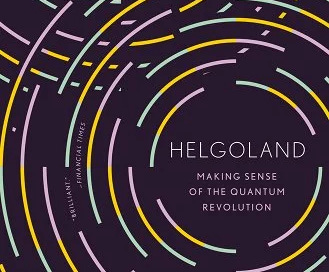Writer’s note: my specialty is in neither science nor math, so I would ask the reader to be aware that I come at this with a spirit of curiosity rather than as any sort of expert, and thus may very well explain some of this badly. I encourage you to read the source book for a better understanding of what I’m saying here.
At the end of Carlo Rovelli’s Helgoland: Making Sense of the Quantum Revolution, he draws our attention to an arresting fact: most of what we see is, in a sense, a hallucination.
Intuitively, we suspect that the way our eyes work are as follows: They see something, then they send a message to our brain, and our brain constructs an image based on the signals our eyes sent it. But neuroscientists have recently discovered that it is the reverse: many, if not most, of the signals being sent are from the brain towards the eyes. The brain tells the eyes what it expects, and the eyes serve as a corrective — if they see something that doesn’t fit what we expect, the brain corrects the image and tries to make sense of it.
The implications of this are wild: it means that much of the image we have of the world exists within the brain. “Instead of calling ‘hallucination’ a false perception,” the French philosopher Hippolyte Taine wrote, “we must call external perception ‘a confirmed hallucination.’”
To be clear, I didn’t understand quantum mechanics before reading this book, and I still don’t understand it after reading it. Rovelli is a theoretical physicist who has dedicated his life to quantum mechanics and, he says, even he doesn’t really understand the topic. No one does. But what we do know about this strange field on the edge of scientific inquiry is forcing us to reimagine our entire world.
Accepting human limitations
The book is named after a small archipelago off the coast in Germany in the North Sea, where the scientist Werner Heisenberg first discovered and explained the basics of quantum mechanics. I don’t understand the math at all but basically what happened was this: in the early 20th century, the laws of classical physics began to fall apart. Discoveries from people like Albert Einstein and Max Planck were verifiably true, but directly contradicted the normal laws of physics.
In order to explain these contradictions, physicists like Niels Bohr, Werner Heisenberg, and Erwin Schrodinger developed new mathematical theories that were demonstrably true, but which also seemed to contradict the idea that we live in a clockwork universe that we would, eventually, be able to totally understand and grasp. The universe quantum mechanics portrays is a probabilistic universe — when observing the smallest observable particles, we can’t say they’ll do just one thing, we can only say they may do one of several possible things.
Even the people who studied this early on were totally flummoxed by the implications. The “Schrodinger’s Cat” thought experiment, which has become a sort of pop culture punchline, was one of the field’s founders attempts to point out the ridiculousness of some features of quantum theory.

Many of the questions raised by quantum mechanics remain unsolved to this day — some people suggest that the probabilistic nature of the theory implies that with each possible outcome, the universe splits, meaning there are an infinite number of alternative realities (which I admit, is an idea I really, really like, especially when I’m stoned).
No matter what the explanation is, the answer is going to be really trippy. Rovelli was a hippie in his teens and twenties, and dabbled in psychedelic drug use. He credits that experimentation with his interest in physics, as LSD and other drugs seemed to blow a hole in his perception of reality.
One thing that we may have to accept, in our quest to understand the universe, is that we simply can’t ever truly understand it in its totality. This is anathema to anyone who believes in the power of human rationality, but it is very obviously true: We have no problem accepting that, for example, a cricket can’t do algebra, or that a dog couldn’t build a rocketship.
Why should it be so hard for us to accept that we, too, may have limits to what we can wrap our brains around? Rovelli implies that quantum mechanics may be one of the places that we butt up against our limitations, but doesn’t give up hope on the possibility that we may be able to one day understand the nature of the universe better, or that we could one day unite relativity and quantum mechanics in the elusive “theory of everything” that everyone from Einstein to Hawking has sought for the past century.
The web of existence
Rovelli’s personal favorite interpretation of quantum mechanics is relational quantum mechanics, which the latter half of this book is dedicated towards explaining. It is fascinating, even if you don’t fully understand it: what he suggests is that there is no overarching, external “God” reality in the universe. Reality is, instead, just the relationship between one object and another.
Take something simple: The sky. If I were to ask you to describe it, like the the first thing you’d say about it is that it’s blue.
But the sky isn’t blue — that is a result of the light traveling from the sky interacting with your retina. Your retina, communicating with your brain, then builds an image in your head that perceives the sky as blue. An animal that couldn’t see “blue” wavelengths (or that could see even more complexity in color, as discussed in previous Book Rex entry An Immense World), would have a different experience of the sky.
This doesn’t mean that nothing is real — obviously, there are real things outside your mind that interact with it and make it see stuff like blue skies or cats or smell stuff like a newborn baby’s head. It just means that what we see as real is real in relation to us. The sky couldn’t be blue if there wasn’t someone who was capable of seeing it as blue.
This is wild, dizzying stuff, and it is impossible to wrap your head fully around. But Rovelli’s vision of the universe — which is as plausible an explanation of reality as parallel universes — sees us not as individuals, but as nodes in a massive web of reality. There is no “I” in this conception of reality — instead, all human bodies are ongoing, infinitely complex processes that are also part of much larger processes in the world, in the solar system, in the galaxy, and in the universe as a whole.
The universe, as the saying goes, may not only be stranger than we imagine, but stranger than we can imagine. Some may hear this and get sick to the stomach, but for my part, being part of a dizzyingly complex universe which I am an inextricable part of is wonderful, and I will happily spend a life exploring it, even if I must resign myself to never being fully capable of understanding it.





